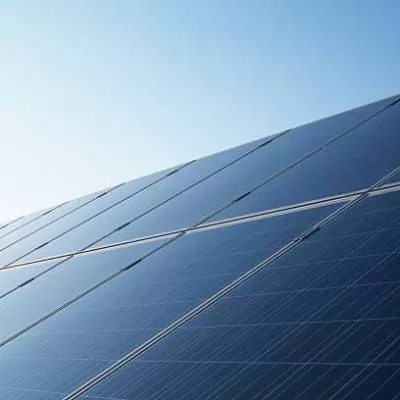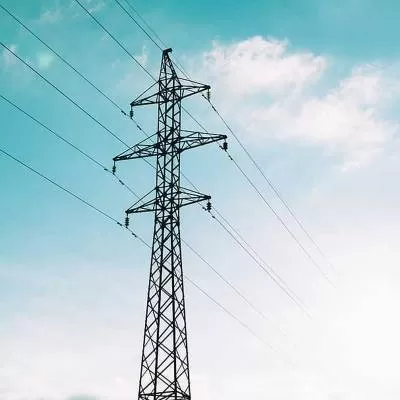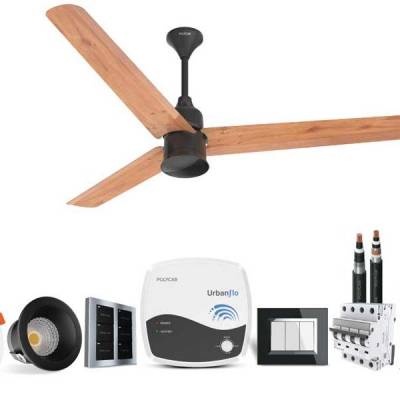- Home
- Infrastructure Energy
- POWER & RENEWABLE ENERGY
- A Cut Above
A Cut Above
The growing palette of roofing materials available today is a bonanza for architects. While sound roofing technologies are being applied to great benefit, their evolution into a more aesthetic avatar is the icing on the cake. A few architects share their use of products to come up with top-class roofs.
Solar Wonder
Product: Building integrated photovoltaic cells (BIPV)Project: Suzlon One Earth Corporate Headquarters
Location: Pune
Concept: The 'Suzlon Excellence Academy' building in the Suzlon One Earth Corporate Headquarters seamlessly integrates architectural design and building services based on green building concepts of energy efficiency and sustainability, thus reflecting Suzlon Energy Ltd's green energy business.
Christopher Benninger, Principal Architect, CCBA Pvt Ltd, explains further, "The Suzlon Excellence Academy is a two-level building, the central foyer of which is provided with a courtyard. While traditional kund type seating is provided at the floor level, the roofing over the courtyard/foyer is with BIPV solar panels. This roof filters in natural light, in a grid-like pattern; this pattern also reflects traditional jaali designs prevalent in Indian architecture."The photovoltaic cells are just one in a series of innovative green features that helped the Suzlon One Earth Corporate Headquarters achieve Platinum LEED certification. This solar roof not only generates electrical energy but provides a 'light filter' screen over the courtyard and prevents heat gain. This solar roof thus obviates the need to air-condition the foyer below."
Material USP: Waterproof and helps generate electricity, thus minimising the load on grid electricity.
Source: Conergy. Tel: 080-4188 0917. Web: www.conergy.com
Cost (from vendor): System price varies according to system size.
Vendor's take: "Conergy (formerly known as SunTechnics) photovoltaic rooftop systems are gaining popularity as regular sources of energy in India," says BS Prasad, Assistant Manager-MarCom, Conergy Energy Systems (I) Pvt Ltd. "Standalone BIPV rooftops have huge potential in the commercial and residential sector as well. They can be used in place of courtyard and terrace covers to enable buildings to minimise their dependence on grid electricity. Suzlon's standalone BIPV takes the load off its lighting and computer systems."
Sleek & Simple
Product: Galvalume sheetsProject: Bus Terminal
Location: Gadag, North Karnataka
Concept: Indrajit Kembhavi, Principal Architect, Kembhavi Architecture Foundation, says "Large-span structure metal was our material of choice for this bus terminal. Bright red columns support the delicate galvalume roof resting on sleek trusses, covering the two-levelled bus terminus. The design meets the complex functional needs of a bus terminal - an area that is almost clear of columns makes it easy for the many illiterate passengers to understand zones and movement. The control room on the second floor is also easily accommodated below the high roof. The design also sends out an evocative expression of contemporary development in the otherwise laidback North Karnataka."
Material USP: Galvalume is a steel sheet coated with an alloy of barrier-resistant aluminium and corrosion-fighting zinc (55 per cent aluminium, 43.5 per cent zinc and 1.5 per cent silicon). It is growing popular as an alternative to traditional non-metallic roof systems for its energy-efficient features, ability to reflect heat, long service life, and lower maintenance requirement. It also possesses soundproof, heatproof and rustproof qualities. Galvalume sheets last for at least 20 years and are available pre-coated, which saves time and money on painting.
Source: Essar Hypermart. Customer support 1800-22-5105 (from MTNL & BSNL landlines) or SMS 'STEEL' to 53636. Web: www.essarhypermart.in
Cost (from architect): Rs 265 per sq m.
Vendor's take: According to Dr M Venkatraman, Senior Vice-President & Head-Product Development, Marketing, Essar Steel, "Galvalume provides excellent resistant to corrosion, superior to galvanised steel especially in industrial environments containing acid concentration and humidity. Owing to the basic design of coating with zinc as well as aluminium contents, this steel is suitable for long-term protection from corrosion and is durable."
Tradition with a Twist
Product: Hilux Calcium Silicate Board 12 mmProject: Residence
Location: Khandala
Concept: For this home in Khandala, designer Shabnam Gupta of The Orange Lane opted to create a traditional looking roof out of structural supports made of timber overlaid with Hilux calcium silicate boards and with an outer layer of conventional terracotta Mangalorean roofing tiles. "The twist lies in the inner layer of Hilux boards," she explains. "Vernacular roofs involve a timber structure overlaid with a skeleton of wood sections. Interlocking clay tiles cover this layer. But such roofs require high-maintenance and are fragile. We used Hilux boards instead of the wooden skeleton to enhance the efficiency of the roof. If we had needed to keep noise out, two layers of Hilux boards could even have been sandwiched with glass wool insulation. Then we cemented the tiles to the boards instead of simply placing them on the base as is conventionally done. This enhanced the overall strength of the structure and simplified maintenance."
Material USP: Hilux lightweight boards serve as thermal insulation and eliminate seepages during the monsoons as they are water-resistant. They also offer some protection against fire.
Source: Advance Plywood. Tel: 022-2503 9849 (imported Hilux board).
Cost (from vendors): Rs 46 per sq ft (imported), Rs 36 per sq ft (Indian made)
Vendor's take: "Calcium silicate (Hilux) boards were introduced a few years ago, thanks to our technical collaboration with A&A Material Corporation, Japan," says Subrata Dey, Marketing Manager, Ramco Industries Ltd. "Hilux board is appreciated for its application possibilities spanning the edifice interior as well as semi-exterior. It competes against other drywall systems - gypsum (the current leader), plywood, mineral fibre products, and cement boards - all lightweight energy-conserving building materials that can virtually eliminate brick and mortar walls. Hilux boards are used for partitions, suspended ceilings and wall panels, which shows how versatile they are vis-a-vis the rest. It clubs the best features of gypsum, fibre cement and wood boards, being water, termite, microbe and fire-resistant, aesthetic, robust, and dimensionally stable."
Connecting Principle
Product: Polycarbonate modular systems 16 mm thick, matte finish, bronze colour, from GallinaProject: Pathways School Location: Gurgaon, Faridabad Road
Concept: "Pathways School's new campus is spread over 11 acre and housed in three connected blocks,- explains Ishwak Singh, Principal Architect, Fabconcept. "Each block is styled like conventional Indian residential architecture, with the built-up area surrounding a central courtyard. These courtyards as well as the connecting spaces between the blocks are covered with polycarbonate modular systems; the idea being that the central open areas and connecting intervals snake through the built-up area as a homogenous space wherein students can play and move freely even in inclement weather, such as strong sun and rain. We found that the 16 mm thick product from Gallina was well suited for our technical requirement."
Material USP: Gallina products can be customised in accordance with individual site requirements, thus offering flexibility in terms of design, light transmission and specially tailored panel lengths like never before. This adds another dimension to customer satisfaction.
Source: Gallina India Pvt Ltd. Tel: 011-2539 1732. E-mail: info@gallina.in
Cost: Depends on the specifications and thickness.
Vendor's take: "Gallina is excited to be an integral part of the Indian polycarbonate market," says Ram Avtar Sharma, CEO, Gallina India Pvt Ltd. "Polycarbonate is a green building material that allows designers to fully and easily express concepts. On top of that, Gallina believes in innovation and improvisation for individual site requirements. Thus, we offer 'concept to realisation' support. Strong customer service and technical assistance in terms of proper pro¡duct selection and compatible structural design are also helping to expand our market."
Layered Butterfly
Product: Sandwiched butterfly roof made of ply, thermocol, cement sheet, steel sheet, and wood fitted on MS framingProject: Brick house, a private residence
Location: Ahmedabad
Concept: "We wanted to include skylights in the two upper-level bedrooms,- explains Hiren Patel of Hiren Patel Architects. "But overhead skylights would let excessive light and glare enter the room, especially during summer. An alternate was to include side skylights to allow indirect light into the space. Two such side skylights are created on the first floor of this residence. The side skylight involves further elevating the opening in the slab - in glass so as to allow light in. To maximise the indirect light entering the room, we opted for an elongate V-shaped butterfly roof for the skylight. An RCC concrete gutter made at the junction of the V-shape serves as a collection channel for rainwater falling on the roof. To maximise inside comfort, the butterfly roof is layered; it is framed in mild steel over which lies a ply sheet, thermocol layer, cement and steel sheets, and finally a layer of wood."
Material USP: Layers of insulation sandwiched between cement sheet and ply/wood offer requisite temperature control while the steel sheet adds strength to the overall roof.
Source: Greenply (for ply and wood). E-mail: sales.ply@green ply.com; local vendors for thermocol, cement and steel sheets.
Cost (from architect): Rs 500 per sq ft (roof).
Vendor's take: "The concept of a layered roof is really interesting," says Jyoti Kant, AGM-Brands, Greenply Industries Ltd. "We welcome such innovative applications of our plywood. Apart from the design aspects of such an application, there would surely be other advantages of using our exterior grade plys, like the light weight of the roofing for skylight applications as well as insulation from heat and acoustics." Meanwhile, Greenply has also introduced a range of compressed composite plys reinforced with metal, which are already being used for the automobile and construction industries and perhaps could be developed further for such specialised applications in future."
Deceptively Vernacular
Product: Decra Roofs (AHI Roofing) Project: White Mountain Resorts (P) LtdLocation: Thangdhar, District Chamba, Uttaranchal
Concept: "We wanted the roof to give the effect of locally found slate stone but be more efficient and long-lasting than conventional slate roofing. We realised that AHI Roofing from New Zealand, marketed under the name Decra Roofs, meets these aims," says Geeta Uppal, Principal Architect, Sandeep Geeta & Associates. Decra Roofs is basically a Zincalume steel tile to which natural stone chips have been bonded using acrylic resins cured by the latest heat technologies. The chips are protected by a clear acrylic overglaze. "It comes in various stone options though we chose slate for this project," she adds. "AHI Roofing also suited this project because the tiles make for a very lightweight roof. Local weather conditions are changing and can be quite severe. As the tiles interlock with a unique horizontal fastening system, they make a strong roof with superior wind and rain penetration resistance."
Material USP: AHI Roofs are hail, fire and corrosion resistant, possess insulating properties, offer some noise protection, and need very little maintenance. They are extremely lightweight - about 7 kg per sq m which is about 1/7th the weight of clay tiles.
Source: NP Roofing India Pvt Ltd. Naresh Sharma.
Mobile: (0) 98182 36833. E-mail: naresh_nproofings@yahoo.com Web: www.ahiroofing.com
Cost (from architect): Rs 185 per sq ft without framework.
Vendor's take: ôDecra Roofs has been around in India for more than six years now," says Naresh Sharma, Director, NP Roofings India Pvt Ltd. "Decra Roofing tiles are ideal for villas, resorts/hotels, schools, banquet halls and any building designed with an inclined roof. We have had takers in cities as well as hill resorts. As this is an imported product, it is priced slightly high but is more economical than simple powder-coated galvalume steel sheets as Decra Roofing tiles are long-lasting and almost maintenance free. We are pushing for this product to be used for Delhi Metro projects, where we believe they will perform better than the existing galvalume steel. The biggest cost advantage vis-a-vis conventional roofs is that they need less structural support as they are lightweight."
Shingle Delight
Product: 'Landmark TL' CertainTeed super premium shingles from Saint GobainProject: Individual bungalows (two)
Location: Kolhapur
Concept: Architect Anand Bhagat and Amala Sheth of Metaphors Architects, Pune, opted for shingles for the ambitious roofs of these bungalows for their aesthetics and flexibility, which made it easier to fix in delicate curves over the concrete and fibre cement board substrate. The top-line shingles with a triple laminate design in the shade Aged Bark, carry a lifetime warranty.
Material USP: Superior aesthetic appeal with international feel; features like being waterproof, unbreakable, and flexible; and warranties ranging from 20 to 50 years make shingles an undisputed value-for-money product.
Source: Building Products & Solutions, Saint-Gobain Grindwell Norton Ltd. Tel: 080-3097 8621/402. Email: connect2bps@saint-gobain.com Web: www. sgbps.com
Cost (from vendor): Saint-Gobain CertainTeed roofing shingles range starts at about Rs 100 per sq ft for economy product and goes up to Rs 350 to 400 per sq ft for the super premium segments.
Vendor's take: "Saint-Gobain, through CeratinTeed, its group company from the US, is promoting shingles in the Indian market," says Harish V Holalu, Senior Manager, Building Products & Solutions, Saint-Gobain, Grindwell Norton Ltd. "CertainTeed products are well suited for mass-class housing projects like row houses and gated communities where they bring a host of technical benefits beyond conventional clay tiles. Shingles need specialised application skills and these are easier to arrange in large projects."
Clear Winner
Product: Laminated Glass 12 mm thick from Asahi India Glass Ltd Project: Classic Marble Company officeLocation: Silvassa
Concept: "The glass roof covering the centre of the office reception acts as a skylight, ensuring that the entire reception is awash with light," explains Zubin Zainuddin, Principal Architect, ZZ Architects. "Streaming daylight lights up the 30 ft high onyx dry cladding, adding glamour to the space. We opted for 12 mm thick laminated glass from Asahi as it was easily available with the supplier in Silvassa. This glass used on a lattice framework in steel makes the structure seamless."
Material USP: Asahi India Glass's ecosense range can be laminated to have better protection from the sun and safety as it blocks 99 per cent UV rays. It is safe and offers better sound insulation than tempered glass of the same thickness. The glass stays in position in case of breakage.
Source: Asahi Glass; Web: www.aisglass.com or www.asahiindia.com
Cost (from vendor): Rs 200 per sq ft onwards.
Vendor's take: "There could be multiple solutions for glass roofing, but at a minimum level. Laminated glass should be used so that the glass stays in position in case of breakage and does not fall," says Rakesh Awasthi, Zonal Head, Projects (North Zone), Asahi India Glass Ltd. "Other options could be AIS heat-strengthened laminated glass; 1.52 PVB lamination strengthens the glass further so a person can walk on the roof for cleaning purposes. Also, AIS designs roofing glass to suit the needs of individual applications."
The growing palette of roofing materials available today is a bonanza for architects. While sound roofing technologies are being applied to great benefit, their evolution into a more aesthetic avatar is the icing on the cake. A few architects share their use of products to come up with top-class roofs. Solar WonderProduct: Building integrated photovoltaic cells (BIPV) Project: Suzlon One Earth Corporate Headquarters Location: Pune Concept: The 'Suzlon Excellence Academy' building in the Suzlon One Earth Corporate Headquarters seamlessly integrates architectural design and building services based on green building concepts of energy efficiency and sustainability, thus reflecting Suzlon Energy Ltd's green energy business. Christopher Benninger, Principal Architect, CCBA Pvt Ltd, explains further, The Suzlon Excellence Academy is a two-level building, the central foyer of which is provided with a courtyard. While traditional kund type seating is provided at the floor level, the roofing over the courtyard/foyer is with BIPV solar panels. This roof filters in natural light, in a grid-like pattern; this pattern also reflects traditional jaali designs prevalent in Indian architecture.The photovoltaic cells are just one in a series of innovative green features that helped the Suzlon One Earth Corporate Headquarters achieve Platinum LEED certification. This solar roof not only generates electrical energy but provides a 'light filter' screen over the courtyard and prevents heat gain. This solar roof thus obviates the need to air-condition the foyer below. Material USP: Waterproof and helps generate electricity, thus minimising the load on grid electricity. Source: Conergy. Tel: 080-4188 0917. Web: www.conergy.com Cost (from vendor): System price varies according to system size. Vendor's take: Conergy (formerly known as SunTechnics) photovoltaic rooftop systems are gaining popularity as regular sources of energy in India, says BS Prasad, Assistant Manager-MarCom, Conergy Energy Systems (I) Pvt Ltd. Standalone BIPV rooftops have huge potential in the commercial and residential sector as well. They can be used in place of courtyard and terrace covers to enable buildings to minimise their dependence on grid electricity. Suzlon's standalone BIPV takes the load off its lighting and computer systems. Sleek & SimpleProduct: Galvalume sheets Project: Bus Terminal Location: Gadag, North Karnataka Concept: Indrajit Kembhavi, Principal Architect, Kembhavi Architecture Foundation, says Large-span structure metal was our material of choice for this bus terminal. Bright red columns support the delicate galvalume roof resting on sleek trusses, covering the two-levelled bus terminus. The design meets the complex functional needs of a bus terminal - an area that is almost clear of columns makes it easy for the many illiterate passengers to understand zones and movement. The control room on the second floor is also easily accommodated below the high roof. The design also sends out an evocative expression of contemporary development in the otherwise laidback North Karnataka. Material USP: Galvalume is a steel sheet coated with an alloy of barrier-resistant aluminium and corrosion-fighting zinc (55 per cent aluminium, 43.5 per cent zinc and 1.5 per cent silicon). It is growing popular as an alternative to traditional non-metallic roof systems for its energy-efficient features, ability to reflect heat, long service life, and lower maintenance requirement. It also possesses soundproof, heatproof and rustproof qualities. Galvalume sheets last for at least 20 years and are available pre-coated, which saves time and money on painting. Source: Essar Hypermart. Customer support 1800-22-5105 (from MTNL & BSNL landlines) or SMS 'STEEL' to 53636. Web: www.essarhypermart.in Cost (from architect): Rs 265 per sq m. Vendor's take: According to Dr M Venkatraman, Senior Vice-President & Head-Product Development, Marketing, Essar Steel, Galvalume provides excellent resistant to corrosion, superior to galvanised steel especially in industrial environments containing acid concentration and humidity. Owing to the basic design of coating with zinc as well as aluminium contents, this steel is suitable for long-term protection from corrosion and is durable. Tradition with a TwistProduct: Hilux Calcium Silicate Board 12 mm Project: Residence Location: Khandala Concept: For this home in Khandala, designer Shabnam Gupta of The Orange Lane opted to create a traditional looking roof out of structural supports made of timber overlaid with Hilux calcium silicate boards and with an outer layer of conventional terracotta Mangalorean roofing tiles. The twist lies in the inner layer of Hilux boards, she explains. Vernacular roofs involve a timber structure overlaid with a skeleton of wood sections. Interlocking clay tiles cover this layer. But such roofs require high-maintenance and are fragile. We used Hilux boards instead of the wooden skeleton to enhance the efficiency of the roof. If we had needed to keep noise out, two layers of Hilux boards could even have been sandwiched with glass wool insulation. Then we cemented the tiles to the boards instead of simply placing them on the base as is conventionally done. This enhanced the overall strength of the structure and simplified maintenance. Material USP: Hilux lightweight boards serve as thermal insulation and eliminate seepages during the monsoons as they are water-resistant. They also offer some protection against fire. Source: Advance Plywood. Tel: 022-2503 9849 (imported Hilux board). Cost (from vendors): Rs 46 per sq ft (imported), Rs 36 per sq ft (Indian made) Vendor's take: Calcium silicate (Hilux) boards were introduced a few years ago, thanks to our technical collaboration with A&A Material Corporation, Japan, says Subrata Dey, Marketing Manager, Ramco Industries Ltd. Hilux board is appreciated for its application possibilities spanning the edifice interior as well as semi-exterior. It competes against other drywall systems - gypsum (the current leader), plywood, mineral fibre products, and cement boards - all lightweight energy-conserving building materials that can virtually eliminate brick and mortar walls. Hilux boards are used for partitions, suspended ceilings and wall panels, which shows how versatile they are vis-a-vis the rest. It clubs the best features of gypsum, fibre cement and wood boards, being water, termite, microbe and fire-resistant, aesthetic, robust, and dimensionally stable. Connecting PrincipleProduct: Polycarbonate modular systems 16 mm thick, matte finish, bronze colour, from Gallina Project: Pathways School Location: Gurgaon, Faridabad Road Concept: Pathways School's new campus is spread over 11 acre and housed in three connected blocks,- explains Ishwak Singh, Principal Architect, Fabconcept. Each block is styled like conventional Indian residential architecture, with the built-up area surrounding a central courtyard. These courtyards as well as the connecting spaces between the blocks are covered with polycarbonate modular systems; the idea being that the central open areas and connecting intervals snake through the built-up area as a homogenous space wherein students can play and move freely even in inclement weather, such as strong sun and rain. We found that the 16 mm thick product from Gallina was well suited for our technical requirement. Material USP: Gallina products can be customised in accordance with individual site requirements, thus offering flexibility in terms of design, light transmission and specially tailored panel lengths like never before. This adds another dimension to customer satisfaction. Source: Gallina India Pvt Ltd. Tel: 011-2539 1732. E-mail: info@gallina.in Cost: Depends on the specifications and thickness. Vendor's take: Gallina is excited to be an integral part of the Indian polycarbonate market, says Ram Avtar Sharma, CEO, Gallina India Pvt Ltd. Polycarbonate is a green building material that allows designers to fully and easily express concepts. On top of that, Gallina believes in innovation and improvisation for individual site requirements. Thus, we offer 'concept to realisation' support. Strong customer service and technical assistance in terms of proper pro¡duct selection and compatible structural design are also helping to expand our market. Layered ButterflyProduct: Sandwiched butterfly roof made of ply, thermocol, cement sheet, steel sheet, and wood fitted on MS framing Project: Brick house, a private residence Location: Ahmedabad Concept: We wanted to include skylights in the two upper-level bedrooms,- explains Hiren Patel of Hiren Patel Architects. But overhead skylights would let excessive light and glare enter the room, especially during summer. An alternate was to include side skylights to allow indirect light into the space. Two such side skylights are created on the first floor of this residence. The side skylight involves further elevating the opening in the slab - in glass so as to allow light in. To maximise the indirect light entering the room, we opted for an elongate V-shaped butterfly roof for the skylight. An RCC concrete gutter made at the junction of the V-shape serves as a collection channel for rainwater falling on the roof. To maximise inside comfort, the butterfly roof is layered; it is framed in mild steel over which lies a ply sheet, thermocol layer, cement and steel sheets, and finally a layer of wood. Material USP: Layers of insulation sandwiched between cement sheet and ply/wood offer requisite temperature control while the steel sheet adds strength to the overall roof. Source: Greenply (for ply and wood). E-mail: sales.ply@green ply.com; local vendors for thermocol, cement and steel sheets. Cost (from architect): Rs 500 per sq ft (roof). Vendor's take: The concept of a layered roof is really interesting, says Jyoti Kant, AGM-Brands, Greenply Industries Ltd. We welcome such innovative applications of our plywood. Apart from the design aspects of such an application, there would surely be other advantages of using our exterior grade plys, like the light weight of the roofing for skylight applications as well as insulation from heat and acoustics. Meanwhile, Greenply has also introduced a range of compressed composite plys reinforced with metal, which are already being used for the automobile and construction industries and perhaps could be developed further for such specialised applications in future. Deceptively VernacularProduct: Decra Roofs (AHI Roofing) Project: White Mountain Resorts (P) Ltd Location: Thangdhar, District Chamba, Uttaranchal Concept: We wanted the roof to give the effect of locally found slate stone but be more efficient and long-lasting than conventional slate roofing. We realised that AHI Roofing from New Zealand, marketed under the name Decra Roofs, meets these aims, says Geeta Uppal, Principal Architect, Sandeep Geeta & Associates. Decra Roofs is basically a Zincalume steel tile to which natural stone chips have been bonded using acrylic resins cured by the latest heat technologies. The chips are protected by a clear acrylic overglaze. It comes in various stone options though we chose slate for this project, she adds. AHI Roofing also suited this project because the tiles make for a very lightweight roof. Local weather conditions are changing and can be quite severe. As the tiles interlock with a unique horizontal fastening system, they make a strong roof with superior wind and rain penetration resistance. Material USP: AHI Roofs are hail, fire and corrosion resistant, possess insulating properties, offer some noise protection, and need very little maintenance. They are extremely lightweight - about 7 kg per sq m which is about 1/7th the weight of clay tiles. Source: NP Roofing India Pvt Ltd. Naresh Sharma. Mobile: (0) 98182 36833. E-mail: naresh_nproofings@yahoo.com Web: www.ahiroofing.com Cost (from architect): Rs 185 per sq ft without framework. Vendor's take: ôDecra Roofs has been around in India for more than six years now, says Naresh Sharma, Director, NP Roofings India Pvt Ltd. Decra Roofing tiles are ideal for villas, resorts/hotels, schools, banquet halls and any building designed with an inclined roof. We have had takers in cities as well as hill resorts. As this is an imported product, it is priced slightly high but is more economical than simple powder-coated galvalume steel sheets as Decra Roofing tiles are long-lasting and almost maintenance free. We are pushing for this product to be used for Delhi Metro projects, where we believe they will perform better than the existing galvalume steel. The biggest cost advantage vis-a-vis conventional roofs is that they need less structural support as they are lightweight. Shingle DelightProduct: 'Landmark TL' CertainTeed super premium shingles from Saint Gobain Project: Individual bungalows (two) Location: Kolhapur Concept: Architect Anand Bhagat and Amala Sheth of Metaphors Architects, Pune, opted for shingles for the ambitious roofs of these bungalows for their aesthetics and flexibility, which made it easier to fix in delicate curves over the concrete and fibre cement board substrate. The top-line shingles with a triple laminate design in the shade Aged Bark, carry a lifetime warranty. Material USP: Superior aesthetic appeal with international feel; features like being waterproof, unbreakable, and flexible; and warranties ranging from 20 to 50 years make shingles an undisputed value-for-money product. Source: Building Products & Solutions, Saint-Gobain Grindwell Norton Ltd. Tel: 080-3097 8621/402. Email: connect2bps@saint-gobain.com Web: www. sgbps.com Cost (from vendor): Saint-Gobain CertainTeed roofing shingles range starts at about Rs 100 per sq ft for economy product and goes up to Rs 350 to 400 per sq ft for the super premium segments. Vendor's take: Saint-Gobain, through CeratinTeed, its group company from the US, is promoting shingles in the Indian market, says Harish V Holalu, Senior Manager, Building Products & Solutions, Saint-Gobain, Grindwell Norton Ltd. CertainTeed products are well suited for mass-class housing projects like row houses and gated communities where they bring a host of technical benefits beyond conventional clay tiles. Shingles need specialised application skills and these are easier to arrange in large projects. Clear WinnerProduct: Laminated Glass 12 mm thick from Asahi India Glass Ltd Project: Classic Marble Company office Location: Silvassa Concept: The glass roof covering the centre of the office reception acts as a skylight, ensuring that the entire reception is awash with light, explains Zubin Zainuddin, Principal Architect, ZZ Architects. Streaming daylight lights up the 30 ft high onyx dry cladding, adding glamour to the space. We opted for 12 mm thick laminated glass from Asahi as it was easily available with the supplier in Silvassa. This glass used on a lattice framework in steel makes the structure seamless. Material USP: Asahi India Glass's ecosense range can be laminated to have better protection from the sun and safety as it blocks 99 per cent UV rays. It is safe and offers better sound insulation than tempered glass of the same thickness. The glass stays in position in case of breakage. Source: Asahi Glass; Web: www.aisglass.com or www.asahiindia.com Cost (from vendor): Rs 200 per sq ft onwards. Vendor's take: There could be multiple solutions for glass roofing, but at a minimum level. Laminated glass should be used so that the glass stays in position in case of breakage and does not fall, says Rakesh Awasthi, Zonal Head, Projects (North Zone), Asahi India Glass Ltd. Other options could be AIS heat-strengthened laminated glass; 1.52 PVB lamination strengthens the glass further so a person can walk on the roof for cleaning purposes. Also, AIS designs roofing glass to suit the needs of individual applications.




















